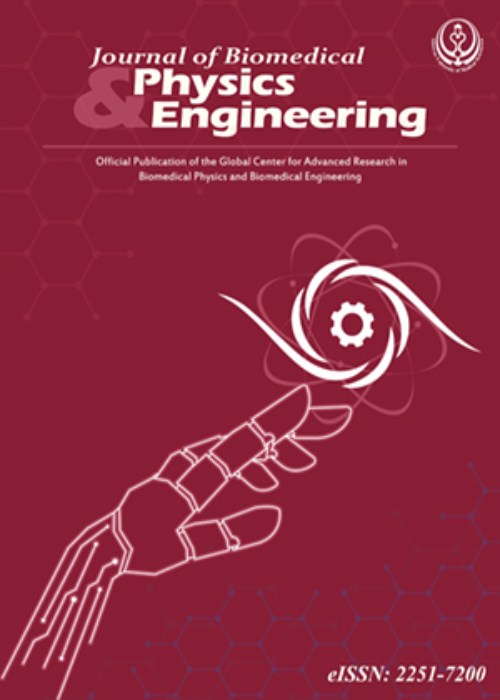فهرست مطالب
Journal of Biomedical Physics & Engineering
Volume:4 Issue: 4, Jul-Aug 2014
- تاریخ انتشار: 1393/10/06
- تعداد عناوین: 6
-
-
Page 117
-
Page 119BackgroundDose assessment using proper dosimeters is especially important in radiation protection optimization and imaging justification in diagnostic radiology.ObjectiveThe aim of this study is to obtain the Entrance Skin Dose (ESD) of patients undergoing lumbar spine imaging using two thermoluminescence dosimeters TLD-100 (LiF: Mg, Ti) and GR-200 (LiF: Mg, Cu, P) and also to obtain the absorbed dose to different organs in lumbar spine imaging with several views.MethodsTo measure the ESD values of the patients undergoing lumbar spine imaging, the two TLD types were put on their skin surface. The ESD values for different views of lumbar spine imaging were also measured by putting the TLDs at the surface of the Rando phantom. Several TLD chips were inserted inside different organs of Rando phantom to measure the absorbed dose to different organs in lumbar spine imaging.ResultsThe results indicate that there is a close agreement between the results of the two dosimeters. Based on the results of this experiment, the ESD dose of the 16 patients included in this study varied between 2.71 mGy and 26.29 mGy with the average of 11.89 mGy for TLD-100, and between 2.55 mGy and 27.41 mGy with the average of 12.32 mGy for GR-200 measurements. The ESDs obtained by putting the two types of TLDs at the surface of Rando phantom are in close agreement.ConclusionAccording to the results, the GR200 has greater sensitivity than the TLD-100.
-
Page 127BackgroundHigh-energy linear accelerator (linac) is a valuable tool and the most commonly device for external beam radiation treatments in cancer patients. In the linac head, high-energy photons with energies above the threshold of interaction produce photoneutrons. These photoneutrons deliver the extra dose to the patients in the planning treatment and increase the risk of secondary cancer.ObjectiveIn this study, a simplified model of the linac head was simulated and photoneutron dose equivalent was calculated at the isocenter and maze in the sphere detector. In addition, the absorbed and equivalent dose of photoneutron were estimated in the some organs of the phantom.MethodsThe simulations were made using the Monte Carlo code. The ICRP reference adult male voxel phantom was used as the human body model for dosimetry calculations.ResultsThe results of dose calculations in the isocenter and maze showed that photoneutron dose decreases as the function of distance from the isocenter and increases with increasing the distance from the entrance maze.ConclusionIt is concluded that the simplified model of linac head is a useful and reliable method in dosimetry calculations. Calculations illustrated that the photoneutron dose is not negligible and duo to its harmful biological effects on body, it should be considered in the treatment plans.
-
Page 141BackgroundRecent studies in eye plaque brachytherapy have shown a considerable difference between the dosimetric results using water phantom and a model of human eye containing realistic materials. In spite of this fact, there is a lack of simulation studies based on such a model in proton therapy literatures. In the presented work, the effect of utilizing an eye model with ocular media on proton therapy is investigated using the MCNPX Monte Carlo Code.MethodsTwo different eye models are proposed to study the effect of defining realistic materials on dose deposition due to utilizing pencil beam scanning (PBS) method for proton therapy of ocular melanoma. The first model is filled with water, and the second one contains the realistic materials of tumor and vitreous. Spread out Bragg peaks (SOBP) are created to cover a typical tumor volume. Moreover, isodose curves are figured in order to evaluate planar variations of absorbed dose in two models.ResultsThe results show that the maximum delivered dose in ocular media is approximately 12-23% more than in water phantom. Also it is found that using the optimized weighted beams in water phantom leads to disturbance of uniformity of SOBP in ocular media.ConclusionSimilar to the results reported in eye brachytherapy published papers, considering the ocular media in simulation studies leads to a more realistic assessment of sufficiency of the designed proton beam in tissue. This effect is of special importance in creating SOBP, as well as in delivered dose in the tumor boundaries in proton pencil beam scanning method.
-
Page 151Background And ObjectiveIn magnetic fluid hyperthermia therapy, controlling temperature elevation and optimizing heat generation is an immense challenge in practice. The resultant heating configuration by magnetic fluid in the tumor is closely related to the dispersion of particles, frequency and intensity of magnetic field, and biological tissue properties.MethodsIn this study, to solve heat transfer equation, we used COMSOL Multiphysics and to verify the model, an experimental setup has been used. To show the accuracy of the model, simulations have been compared with experimental results. In the second part, by using experimental results of nanoparticles distribution inside Agarose gel according to various gel concentration, 0.5%, 1%, 2%, and 4%, as well as the injection velocity, 4 µL/min, 10 µL/min, 20 µL/min, and 40 µL/min, for 0.3 cc magnetite fluid, power dissipation inside gel has been calculated and used for temperature prediction inside of the gel.ResultsThe Outcomes demonstrated that by increasing the flow rate injection at determined concentrations, mean temperature drops. In addition, 2% concentration has a higher mean temperature than semi spherical nanoparticles distribution.ConclusionThe results may have implications for treatment of the tumor and any kind of cancer diseases.
-
Page 163The radiation-induced bystander effect is the phenomenon which non-irradiated cells exhibit effects along with their different levels as a result of signals received from nearby irradiated cells. Responses of non-irradiated cells may include changes in process of translation, gene expression, cell proliferation, apoptosis and cells death. These changes are confirmed by results of some In-Vivo studies. Most well-known important factors affecting radiation-induced bystander effect include free radicals, immune system factors, expression changes of some genes involved in inflammation pathway and epigenetic factors.


